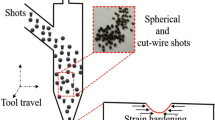Abstract
Fatigue tests have been conducted on Ti-6Al-4V from 293 to 589 K to determine the influence of surface residual stresses and surface topography on low and high cycle fatigue properties. Four types of machined surfaces as well as shot peened surfaces were included in the investigation. It was found that surface residual stresses play a key role in controlling the development of microcracks and, therefore, overall fatigue lives at both room and elevated temperature. X-ray measurement of the stability of surface residual stresses under thermal activation and/or cyclic loading demonstrated that, for the conditions studied, cyclic loading was primarily responsible for residual stress decay. In addition, the magnitude of the decay was dependent on the relationship between the sign of the residual stress and the sign of the imposed mean strain. Finally, it was demonstrated that the sharpness of machining grooves is more important than their depth in controlling fatigue resistance.
Similar content being viewed by others
References
E. C. Reed and J. A. Viens:Trans. ASME, Series B, 1960, vol. 82, p. 76.
P. S. Prevey and W. P. Koster: ASTM STP 520, p. 522, 1973.
D. N. Williams and R. A. Wood: Effects of Surface Condition on the Mechanical Properties of Titanium and Its Alloy, MCIC-71-01, August, 1971.
P. S. Maiya:Scr. Met., 1975, vol. 9, p. 1277.
A. Yuen, S. W. Hopkins, G. R. Leverant, and C. A. Rau:Met. Trans., 1974, vol. 5, p. 1833.
R. H. Marion and J. B. Cohen:Advances in X-ray Analysis, vol. 18, p. 466, 1974.
R. H. Marion and J. B. Cohen:J. Appl. Crystallog., 1975, vol. 8, p. 430.
P. S. Prevey: Proc. of Workshop on Nondestructive Evaluation of Residual Stress, NTIAC-76-2, p. 62, 1976.
L. H. Burck, C. P. Sullivan, and C. H. Wells:Met. Trans., 1970, vol. 1, p. 1595.
C. Laird: ASTM STP 415, p. 131, 1967.
J. H. Weber and R. W. Hertzberg:Met. Trans., 1973, vol. 4, p. 595.
A. S. Tetelman and A. J. McEvily: Fracture of Structural Materials, p. 48, John Wiley & Sons, 1967.
Author information
Authors and Affiliations
Additional information
The work was performed when all authors were affiliated with Pratt and Whitney Aircraft, Middletown, Connecticut.
Rights and permissions
About this article
Cite this article
Leverant, G.R., Langer, B.S., Yuen, A. et al. Surface residual stresses, surface topography and the fatigue behavior of Ti-6AI-4V. Metall Trans A 10, 251–257 (1979). https://doi.org/10.1007/BF02817635
Received:
Issue Date:
DOI: https://doi.org/10.1007/BF02817635




